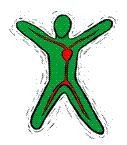DNA: The Alphabet of Life
This lesson and worksheet provides and overview of DNA structure and function with an emphasis on the application of DNA knowledge to human health.
Objectives:
• Students will know what DNA stands for.
• Students will be able to name the component parts of a DNA molecule.
• Students will be introduced to the vast size of the human genome.
• Students will learn the general purpose of DNA.
• Students will identify where in a cell DNA is located.
• Students will relate DNA mutation to genetic disease.
Suggested Grades:
6th Grade - 7th Grade - 8th Grade
Print the reading comprehension passage and questions (see below).
Students should read the passage silently, then answer the questions. Teachers may also use the text as part of a classroom lesson plan.
Lesson Excerpt:
If you have watched TV lately, you probably heard about DNA used as evidence by the police. From a tiny speck of blood, lab workers can get enough DNA to identify a person. DNA has become a powerful tool in crime fighting, and it is also helping us to learn more about human health and disease than we ever could before. DNA stands for deoxyribonucleic acid, and it is the molecule that acts like a blueprint for building our bodies. Watson and Crick discovered the structure of DNA just over 50 years ago and won a Nobel Prize for their work.
DNA's structure is actually quite simple. A DNA molecule has three basic parts: a sugar, a phosphate group, and a nitrogen base. DNA is in the shape of a double helix, which is much like a ladder twisted into a spiral. The sugar and phosphate molecules are the sides of the ladder, and they keep the shape of the molecule. The rungs of the ladder are made up of the nitrogen bases:
Continued...

Lesson Printables:
Print this printable worksheet for this lesson:


